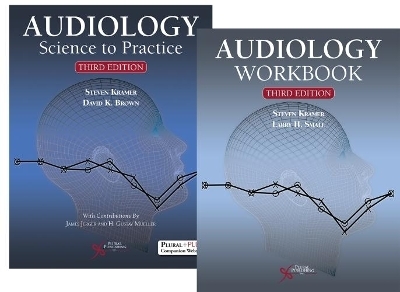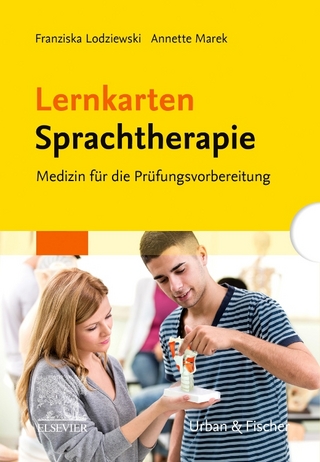
Audiology
Science to Practice Bundle (Textbook + Workbook)
Seiten
2018
|
3rd New edition
Plural Publishing Inc
978-1-63550-069-1 (ISBN)
Plural Publishing Inc
978-1-63550-069-1 (ISBN)
- Titel ist leider vergriffen;
keine Neuauflage - Artikel merken
For introductory courses on audiology or hearing science, this textbook and workbook bundle provides a comprehensive overview of the subject.
''Audiology: Science to Practice, Third Edition Bundle (Textbook and Workbook)'' is a comprehensive and challenging textbook and companion workbook for undergraduate courses in audiology and hearing science, and for graduate students beginning an AuD program who may not have a previous background in the subject. It is designed to cover the content of both two-course sequences (Hearing Science and Principles of Audiology) as well as combined courses - providing a level of consistency in presentation. Chapters cover hearing science, diagnostic procedures, an introduction to hearing aids, and extensive coverage of anatomy and physiology of the auditory and vestibular systems. Steven Kramer has taught an "Introduction to Audiology" course for more than 20 years, and has truly designed this text with the student in mind. This edition seeks to cover the entire scope of audiology from otoscopy to electrophysiology.
The textbook has been extensively revised from the previous edition. This edition has systematically reviewed each of the chapters from the previous edition to expand, update, and reorganize the material to make it even more useful to the student new to audiology, and at the same time it continues to be more comprehensive than one might find in other introductory texts on audiology. The authors retain the features that worked well in previous editions, including an easy to read format, key learning objectives, synopses within each chapter with bulleted highlights for review. Chapters are now organized in a more traditional sequence beginning with information about the profession of audiology, followed by acoustics, anatomy/physiology, and clinical audiology. References and figures have been updated, including photos of new hearing instruments and amplification devices, and new figures on the anatomy of the auditory and vestibular systems.
Another substantive change includes a revision of the chapter on Hearing Aids to make it more appropriate for the undergraduate student or others who want an overview of this important part of audiology. Four new chapters have been added to this edition: Outer and Middle Ear Assessment, Evoked Responses, Implantable Devices, and Vestibular Systems. This edition also now comes with a PluralPlus companion website.
The companion ''Audiology Workbook'' includes activities such as drawing and labeling diagrams, drawing waveforms, calculating frequencies/periods, amplitudes, and phases, interpreting audiograms, speech tests, tympanograms, acoustic reflexes, and auditory brainstem responses. There are also questions to reinforce knowledge about hearing disorders, as well as basic understanding of hearing aids and their fittings. Activities are comprehensive and designed so that they may be solved with relatively short answers and useful for group discussion.
The ''Audiology Workbook'' has been extensively revised from the previous edition. This edition updates, expands, and reorganizes material from previous editions, but retains the features that worked well, including detailed answers for all of the exercises. More exercises have been added in traditionally difficult areas such as properties of sound, anatomy/physiology, audiogram interpretation/description, and masking. In addition, there are now separate chapters on immittance, OAEs and ABRs, as well as a chapter on the vestibular system and its assessment. New to this edition is a separate chapter on vestibular anatomy, physiology, disorders, and assessments for those who wish to learn more about this area of audiology.
The popular case studies have been revised into a more consistent format with answers written similar to how they might be done in a clinical audiology report. There are exercises designed to reinforce knowledge of auditory disorders, and a chapter entirely devoted to case studies in order to help students learn how to integrate basic diagnostic test results and relate them to a variety of hearing disorders.
''Audiology: Science to Practice, Third Edition Bundle (Textbook and Workbook)'' is a comprehensive and challenging textbook and companion workbook for undergraduate courses in audiology and hearing science, and for graduate students beginning an AuD program who may not have a previous background in the subject. It is designed to cover the content of both two-course sequences (Hearing Science and Principles of Audiology) as well as combined courses - providing a level of consistency in presentation. Chapters cover hearing science, diagnostic procedures, an introduction to hearing aids, and extensive coverage of anatomy and physiology of the auditory and vestibular systems. Steven Kramer has taught an "Introduction to Audiology" course for more than 20 years, and has truly designed this text with the student in mind. This edition seeks to cover the entire scope of audiology from otoscopy to electrophysiology.
The textbook has been extensively revised from the previous edition. This edition has systematically reviewed each of the chapters from the previous edition to expand, update, and reorganize the material to make it even more useful to the student new to audiology, and at the same time it continues to be more comprehensive than one might find in other introductory texts on audiology. The authors retain the features that worked well in previous editions, including an easy to read format, key learning objectives, synopses within each chapter with bulleted highlights for review. Chapters are now organized in a more traditional sequence beginning with information about the profession of audiology, followed by acoustics, anatomy/physiology, and clinical audiology. References and figures have been updated, including photos of new hearing instruments and amplification devices, and new figures on the anatomy of the auditory and vestibular systems.
Another substantive change includes a revision of the chapter on Hearing Aids to make it more appropriate for the undergraduate student or others who want an overview of this important part of audiology. Four new chapters have been added to this edition: Outer and Middle Ear Assessment, Evoked Responses, Implantable Devices, and Vestibular Systems. This edition also now comes with a PluralPlus companion website.
The companion ''Audiology Workbook'' includes activities such as drawing and labeling diagrams, drawing waveforms, calculating frequencies/periods, amplitudes, and phases, interpreting audiograms, speech tests, tympanograms, acoustic reflexes, and auditory brainstem responses. There are also questions to reinforce knowledge about hearing disorders, as well as basic understanding of hearing aids and their fittings. Activities are comprehensive and designed so that they may be solved with relatively short answers and useful for group discussion.
The ''Audiology Workbook'' has been extensively revised from the previous edition. This edition updates, expands, and reorganizes material from previous editions, but retains the features that worked well, including detailed answers for all of the exercises. More exercises have been added in traditionally difficult areas such as properties of sound, anatomy/physiology, audiogram interpretation/description, and masking. In addition, there are now separate chapters on immittance, OAEs and ABRs, as well as a chapter on the vestibular system and its assessment. New to this edition is a separate chapter on vestibular anatomy, physiology, disorders, and assessments for those who wish to learn more about this area of audiology.
The popular case studies have been revised into a more consistent format with answers written similar to how they might be done in a clinical audiology report. There are exercises designed to reinforce knowledge of auditory disorders, and a chapter entirely devoted to case studies in order to help students learn how to integrate basic diagnostic test results and relate them to a variety of hearing disorders.
| Erscheint lt. Verlag | 15.1.2018 |
|---|---|
| Verlagsort | San Diego |
| Sprache | englisch |
| Maße | 218 x 279 mm |
| Themenwelt | Medizin / Pharmazie ► Gesundheitsfachberufe ► Logopädie |
| Medizin / Pharmazie ► Medizinische Fachgebiete ► HNO-Heilkunde | |
| ISBN-10 | 1-63550-069-9 / 1635500699 |
| ISBN-13 | 978-1-63550-069-1 / 9781635500691 |
| Zustand | Neuware |
| Haben Sie eine Frage zum Produkt? |
Mehr entdecken
aus dem Bereich
aus dem Bereich
Medizin für die Prüfungsvorbereitung
Lehr- oder Lernkarte (2024)
Urban & Fischer in Elsevier
CHF 54,50


